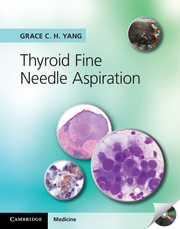Book contents
- Frontmatter
- Dedication
- Contents
- Preface
- 1 Techniques and approaches to ultrasound-guided fine needle aspiration
- 2 Nodular goiter and mimickers
- 3 Follicular neoplasm and mimickers
- 4 Hürthle cell neoplasm and mimickers
- 5 Follicular variant of papillary carcinoma
- 6 Thyroiditis and mimickers
- 7 Papillary thyroid carcinoma and variants with papillae and mimicker
- 8 Papillary thyroid carcinoma, uncommon variants, and mimicker
- 9 Clear cell and mucinous thyroid tumors
- 10 Poorly differentiated thyroid carcinoma
- 11 Anaplastic thyroid carcinoma
- 12 Medullary thyroid carcinoma
- 13 Miscellaneous benign lesions
- 14 Metastatic thyroid carcinoma
- 15 Metastatic and secondary tumors to the thyroid
- 16 Ancillary tests
- Index to case histories
- Index to ultrasound and Doppler images
- General index
- References
3 - Follicular neoplasm and mimickers
Published online by Cambridge University Press: 05 September 2014
- Frontmatter
- Dedication
- Contents
- Preface
- 1 Techniques and approaches to ultrasound-guided fine needle aspiration
- 2 Nodular goiter and mimickers
- 3 Follicular neoplasm and mimickers
- 4 Hürthle cell neoplasm and mimickers
- 5 Follicular variant of papillary carcinoma
- 6 Thyroiditis and mimickers
- 7 Papillary thyroid carcinoma and variants with papillae and mimicker
- 8 Papillary thyroid carcinoma, uncommon variants, and mimicker
- 9 Clear cell and mucinous thyroid tumors
- 10 Poorly differentiated thyroid carcinoma
- 11 Anaplastic thyroid carcinoma
- 12 Medullary thyroid carcinoma
- 13 Miscellaneous benign lesions
- 14 Metastatic thyroid carcinoma
- 15 Metastatic and secondary tumors to the thyroid
- 16 Ancillary tests
- Index to case histories
- Index to ultrasound and Doppler images
- General index
- References
Summary
General pattern
Follicular neoplasms of the microfollicular type contain many more blood vessels than colloid nodules, since there is much less potential space between colloid lakes for blood vessels. Comparison of Doppler, FNA smear and blood vessel density of a resected colloid nodule and a resected follicular adenoma is shown in Fig. 3.1. The author first heard of bloody aspirates of follicular neoplasm in a workshop lecture by the late Torsten Löwhagen in 1989. He told the audience the next step he would use was the two-step smearing technique to concentrate the microfollicles and get rid of the aspirated blood. In his classic study in cytologic presentation of thyroid tumors in 1974, the 10 most cellular smears by gross inspection, including tissue proven follicular adenoma, follicular carcinoma, medullary carcinoma, anaplastic carcinoma, and lymphoma were chosen for the study. No blood was present in his low-power figure of follicular adenoma. Sparse cellular follicular neoplasm was mentioned in the lectures by Oertel and in her publications., High blood vessel density of follicular neoplasms was confirmed by a quantitative study to evaluate follicular patterned lesions. In a study by Giorgadze et al., comparing 14 cases of follicular adenoma, 10 cases of follicular carcinoma and 11 cases of follicular variant of papillary carcinoma, the intratumoral blood vessel density was uniformly high among the follicular patterned thyroid tumors, but highest in follicular adenoma (262±153), intermediate in follicular carcinoma (235±71), and lowest in follicular variant of papillary carcinoma (166±29).
- Type
- Chapter
- Information
- Thyroid Fine Needle Aspiration , pp. 37 - 89Publisher: Cambridge University PressPrint publication year: 2013

